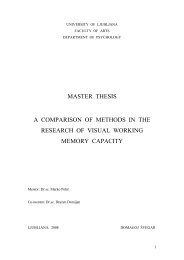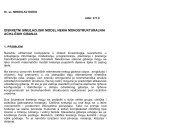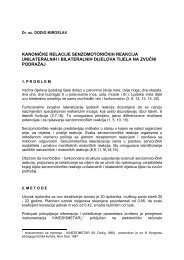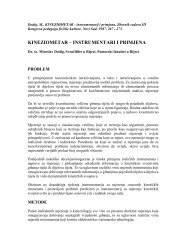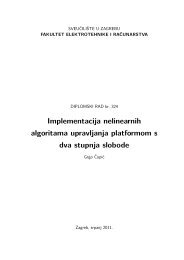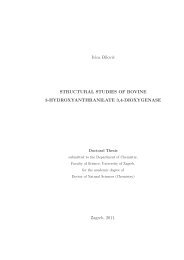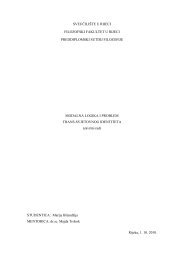Investigating Macroeconomic Determinants of Happiness in ...
Investigating Macroeconomic Determinants of Happiness in ...
Investigating Macroeconomic Determinants of Happiness in ...
Create successful ePaper yourself
Turn your PDF publications into a flip-book with our unique Google optimized e-Paper software.
government expenditure, while section 5 conta<strong>in</strong>s our own empirical <strong>in</strong>vestigation <strong>of</strong> the<br />
impact <strong>of</strong> macroeconomic variables on happ<strong>in</strong>ess <strong>in</strong> transition countries. Section 6 concludes.<br />
2. <strong>Happ<strong>in</strong>ess</strong> functions<br />
In happ<strong>in</strong>ess studies people are, through surveys, directly asked about their<br />
subjective well-be<strong>in</strong>g 1 , <strong>in</strong>stead <strong>of</strong> <strong>in</strong>directly estimat<strong>in</strong>g utility. Traditionally, economists<br />
assume that people’s choices reveal their preferences. If one chooses A over B, then, by<br />
def<strong>in</strong>ition, the utility <strong>of</strong> A is greater than the utility <strong>of</strong> B. From this economists derive the socalled<br />
decision utility. However, <strong>in</strong> recent years attention has been paid to alternative<br />
approach to utility; the so-called experienced utility. Experienced utility refers to the<br />
desirability <strong>of</strong> the experience <strong>of</strong> an outcome. Orthodox economics typically assumes that<br />
decision utility and experienced utility are the same. Psychologists believe that the extent to<br />
which decision utility corresponds to experience utility varies across situations and<br />
<strong>in</strong>dividuals. Introspection and empirical research <strong>in</strong>dicate that there are cases <strong>in</strong> which people<br />
choose A over B but are 100 percent sure <strong>in</strong> retrospect that the experience <strong>of</strong> B would have<br />
been more desirable than the experience <strong>of</strong> A. The existence <strong>of</strong> regret <strong>in</strong> life and <strong>in</strong> the<br />
laboratory can be viewed as empirical evidence that contradicts the orthodox economic<br />
def<strong>in</strong>ition <strong>of</strong> utility. Economic theory assumes that decision utility <strong>of</strong> A higher than decision<br />
utility <strong>of</strong> B implies that the experienced utility <strong>of</strong> A is greater than experienced utility <strong>of</strong> B.<br />
However, <strong>in</strong> the real world, it is possible that the decision utility <strong>of</strong> A is greater than the<br />
decision utility <strong>of</strong> B and the experienced utility <strong>of</strong> B is higher than the experienced utility <strong>of</strong><br />
A (Frisch, 2003). An implicit assumption underly<strong>in</strong>g empirical analysis <strong>of</strong> happ<strong>in</strong>ess<br />
functions, hence, is that survey measures <strong>of</strong> happ<strong>in</strong>ess are closer to experienced utility than to<br />
the decision utility <strong>of</strong> standard economic theory (Di Tella et al., 2003).<br />
The most commonly asked question <strong>in</strong> these types <strong>of</strong> surveys is “Tak<strong>in</strong>g all th<strong>in</strong>gs<br />
together, would you say you are: 1 – very happy, 2 – quite happy, 3 – not very happy, 4 – not<br />
at all happy” 2 . These answers are then used as the dependent variable <strong>in</strong> happ<strong>in</strong>ess equations.<br />
Therefore, given that the dependent variable can have more than one value, and given that the<br />
answers are ord<strong>in</strong>al rather than card<strong>in</strong>al, these k<strong>in</strong>ds <strong>of</strong> models are usually estimated through<br />
ordered probit or logit models. In terms <strong>of</strong> econometric analysis, happ<strong>in</strong>ess is analysed aga<strong>in</strong>st<br />
1 The terms well-be<strong>in</strong>g, life satisfaction and happ<strong>in</strong>ess are <strong>of</strong>ten used <strong>in</strong>terchangeably, as empirically they seem<br />
to measure a very similar concept (Hayo, 2004).<br />
2 In our empirical work we code these answers differently: 4 – very happy, 3 – quite happy, 2 – not very happy, 1<br />
– not at all happy.<br />
3




